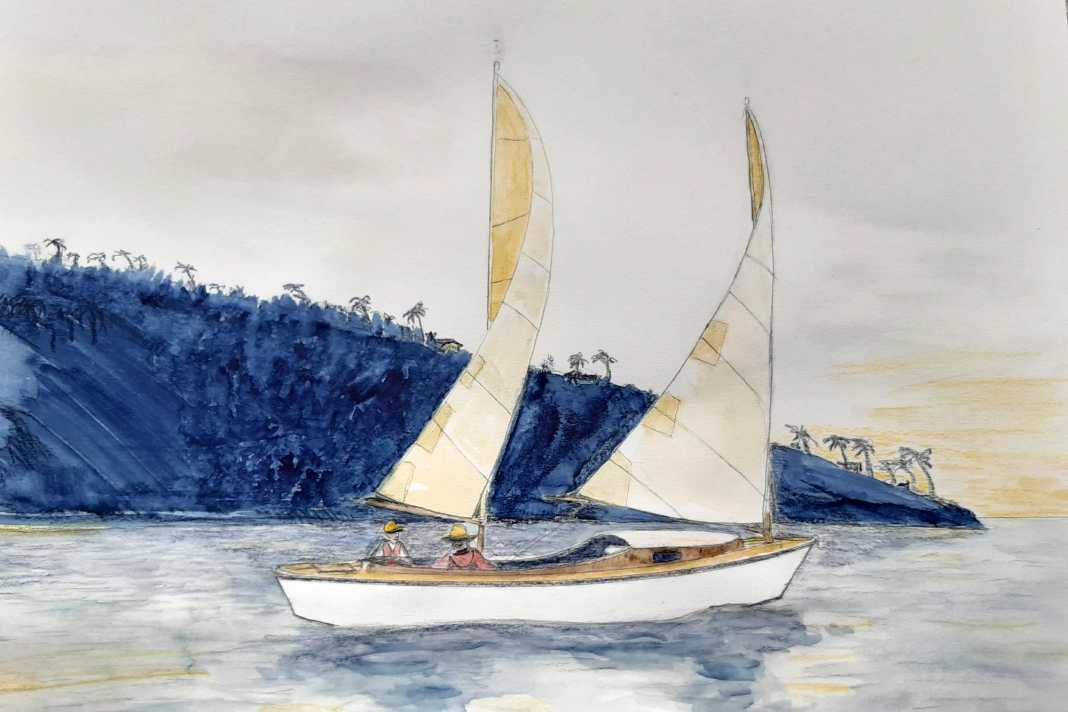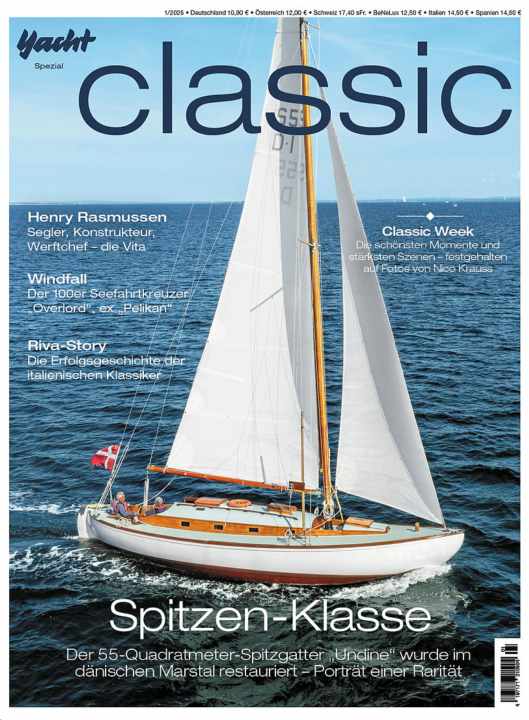Yacht history: From workboat to popular leisure yacht - the triumph of the Sharpies
YACHT-Redaktion
· 13.07.2025






In 19th century America, after the end of the Civil War, the industrialisation of sawmills and the improvement of transport options meant that battens and boards were traded as standard goods. For example, the American two-by-four framing method of house construction, which was made possible by this, only required a wagonload of battens with a cross-section of around five by ten centimetres, a large number of boards and lots of nails - then it was possible to build a house even without trained carpenters.
This might also interest you:
The same was also possible in boat building. Fishermen, farmers and traders built workboats over simple frames with planks, tailored precisely to their needs and at a favourable price. Folding chandlers with flat bottoms had always existed; dories, stackable workboats carried on the upper decks of fishing vessels, were also known in America.
Sharpie is quick and easy to build
For the oyster fishermen in New Haven, who cultivated their shellfish in the brackish waters of Long Island Sound, a stable boat with a flat bottom and mostly round stern was just the thing for drifting with their rakes standing on the covered stern to heave the precious catch directly into the centre and thus the centre of gravity of the boat. The name Sharpie is thought to have originated from the sharp edges, particularly in the bow area.
A distinction was made between one-man and two-man boats. The former were around eight metres long and could carry 75 to 100 bushels - the American bushel. The latter were around ten metres long and carried 150 to 175 bushels. Depending on the region, a bushel could weigh between 40 and 75 kilograms and was calculated at an average of 55 kilograms.
While the smaller Sharpies managed with one mast, the larger ones had three mast tracks and could therefore carry two masts in lighter winds in summer and one mast in the stormy months. The construction of a six metre long workboat could be completed by two craftsmen in around two weeks.
From its beginnings in the Connecticut oyster industry, the Sharpie spread within half a century, adapted to the specific needs of the task at hand, first in inland or coastal waters, before finally venturing out onto the open sea as a yacht.
Sharpies between elegance and box shape
Compared to other boat types, Sharpies are easier and therefore cheaper to manufacture. There is no need for a boat builder to cut open the crack. As work boats, they can be cobbled together in a short space of time using materials that are available everywhere, but they fulfil their purpose. They are very fast, versatile, practical and can take a lot of payload. They are surprisingly seaworthy and, in an emergency, can be surfed to the beach through moderate surf on a leeboard with the centreboard raised like a giant surfboard. Where keel yachts have to follow the fairway, a Sharpie can take the shorter course in knee-deep water close to the wind. Falling dry is no problem.
The Sharpie has a reputation for not being automatically self-righting. A ballast centreboard or internal ballast section, buoyancy bodies and hull openings in the middle can solve this problem. The boat should be sailed with a heel, otherwise the pounding of the waves on the flat bottom can be annoying. At the same time, the waterline is longer, which increases the speed. For this reason, a night at anchor can be less than relaxing. Over the years, both graceful boat cracks and box-shaped constructions have been created, but these have unexpectedly good sailing characteristics.
Munroe spreads Sharpies on the American east coast
One name is always mentioned in connection with the spread of the Sharpie on the American east coast: Commodore Ralph Munroe. He brought the first Sharpie "Kingfisher" from Staten Island to Florida. It was a 33-foot Sharpie designed by him, which was rigged as a gaff ketch with fuel booms.
He sailed the boat along the coast of Biscayne Bay and eventually sold it as a half down payment on a property in Coconut Grove, on the water's edge of which he built a home called the Barnacle and a boathouse in 1891. Munroe and friends founded the Biscayne Bay Yacht Club, the first in the area, and served as its commodore for 22 years. In addition to designing a number of houses adapted to the local climate, which were still unusual for the time, the generalist was one of the first settlers in the Miami region, working as an entrepreneur, sailboat courier, boat builder, celebrated photographer and conservationist. Over the course of his life, he constructed 56 different vessels, mostly Sharpies, which were able to withstand the rough passages in the Gulf Stream outside the bay, but were also able to cross the reefs into shallow harbours.
In the summer of 1886, Munroe designed the 28-foot double-ender Sharpie "Egret". This boat set the standard for all subsequent Sharpie yachts and is still being rebuilt today by professional boat builders and self-builders in various modifications and is still revered by a growing fan base.
Sharpie lifeboat "Egret"
Because the original drawings were lost in a hurricane in 1926, yacht designer Joel White and friends set about creating their own construction plans for the American magazine "WoodenBoat" using old photos. Boat designer Reuel B. Parker, whose excellent standard work "The Sharpie Book" is recommended reading, presents his own interpretation of "Egret".
Munroe called "Egret" his "sharpie lifeboat" because of its seaworthiness. It was used as a workboat and courier boat along the Florida coast. Compared to average Sharpies, the double-ender has higher and, like a dory, more inclined sides. The keel is slightly more pronounced and the transition from flat bottom to bow and stern is above the waterline. The original's slip cabin is divided in the centre by the centreboard box and offers no seat height and no comfort. The sail plan is designed as a cat schooner with a gaff rig and the resulting low sail pressure point, and the ballast was carried amidships in the form of cargo, sandbags or bricks.
In his biography "The Commodore's Story", published in 1930, Munroe recounts, among other things, voyages with "Kingfisher" and "Egret". An extract from it describes the seaworthiness of the boats and boasts of the skipper's skill and local knowledge: "... It was nearly low water. This time the channel crossed the sandbank at the southern end of the opening and continued in a north-westerly direction through surf flanking both sides. No boat - whether under sail or motor - could have coped with the given conditions that morning. "
"With the Sharpie, however, we looked for the shallowest-looking spot at the northern end, took in the mainsail and headed for it. Good luck brought us through just behind the first breaking wave, and before the second wave could catch us, we were safely in a foot of water. A moment later we were dry on the sandbank half a mile from the mainland. From land, our situation looked perilous and Captain Pacetti, the local pilot, launched a rescue operation. If he had known about the seaworthiness of Sharpies and realised that we were brewing coffee, he could have saved himself some trouble."
"When we were having breakfast, the tide came in very quickly. We jumped overboard on both sides and held the bow against the incoming sea. A short time later we were over the sandbank and sailing up the river. Here we met the pilot, whom we could only thank for his well-intentioned rescue operation. We could just hear his question: 'What the hell kind of boat have you got there?' It's obvious that I had introduced this type of boat to the Florida coast! ..."
Munroe and Herreshoff experiment together
The designer Nathanael Herreshoff, known for his elegant and successful racing yachts for the America's Cup, was a good friend of Munroe and a frequent guest of his. The two free spirits experimented with unusual boat shapes. Munroe built and sailed the first American Proa after a lengthy debate about multihulls, while Herreshoff designed his first 7.50 metre catamaran "Amaryllis" in 1875, which won its first regatta in 1876 by a large margin over its competitors.
His son Lewis Francis Herreshoff, inspired by the simplicity and speed of the Sharpies, designed the 33-foot cruising yacht "Meadow Lark", a Sharpie with centreboards. He published the design in his book "Sensible Cruising Designs". Even today, many more or less modified replicas still cruise the world's oceans.
The boat designer, historian and author Howard I. Chapelle was an outspoken fan of the inexpensive yet versatile workboats. In his 1951 book "American Small Sailing Craft", which is regarded as a classic, he documents the history of the dying American workboats and gives the Sharpies a special place.
Bolger builds "Square Boats
With the availability of plywood and epoxy resins, building Sharpies became even easier. The American designer and author Phil Bolger designed many Sharpies for self-builders because he thought the cost-performance ratio of this boat shape was unbeatable. Bolger was of the opinion that the seaworthiness of Sharpies increases with the length-to-width ratio. In his opinion, with sufficient ballast and watertight bulkheads, self-righting in the event of capsizing was also possible. The curve of the crease line should have the same radius throughout, and if possible this should be the same for the side walls and bottom plate in order to avoid turbulence. The bow and stern should both be above the waterline.
Bolger became particularly famous for its square boats, also known disrespectfully as "Bolger boxes". These Sharpies with vertical sides, a cut-off bow and simple sails had and still have a worldwide fan base despite their unusual appearance. The concept of his Sharpie "Birdwatcher", in which the boat is steered from a fully glazed cabin that runs the entire length of the hull, has been a recurring theme among designers ever since. Many of his larger Sharpie designs serve as cruisers for long-distance sailors.
Bruce Kirby, the father of the Laser dinghy, designed the Norwalk Islands Sharpies self-build yachts from 18 to 26 feet with a full-length cat-ketch rig. A variety of Sharpie designs from a wide range of designers can be seen at the increasingly popular Raids. A raid is an organised sailing and rowing tour lasting several days with small boats along the coast. If races are on the programme, the Sharpies usually come out on top due to the characteristics already described.
If you love the shapes of beautiful classic boat cracks, but have the opportunity to sail a Sharpie for the first time, then a problem may arise: You don't find it appropriate that simply carpentered boats can sail so well.

The story of the Sharpies is published in the current issue of YACHT classic, which has been on sale since 21 May (available here). YACHT subscribers get the magazine delivered to their door for free. You can also read the portrait of shipyard founder Henry Rasmussen, the history of the "Nordwest" and look back on Classic Week 2024 in photos by Nico Krauss.

